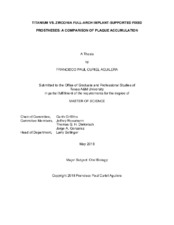| dc.contributor.advisor | Griffiths, Garth | |
| dc.creator | Curiel Aguilera, Francisco Paul | |
| dc.date.accessioned | 2019-01-17T19:08:42Z | |
| dc.date.available | 2020-05-01T06:25:01Z | |
| dc.date.created | 2018-05 | |
| dc.date.issued | 2018-05-02 | |
| dc.date.submitted | May 2018 | |
| dc.identifier.uri | https://hdl.handle.net/1969.1/173538 | |
| dc.description.abstract | The purpose of this prospective, longitudinal, descriptive clinical study is to investigate the plaque accumulation and soft tissue inflammation in maxillary full-arch implant-supported fixed prostheses (FIFP) fabricated with either Titanium (Ti) or Monolithic Zirconia (Zr).
Materials and Methods: Twenty healthy patients participated in the study and were categorized by the type of FIFP in the maxilla (Ti vs. Zr). The prosthesis had to be in function for at least three months and patients had to be enrolled in a 3-month interval maintenance program.
Patients were required to attend three maintenance appointments, scheduled at 3- month intervals. Information collected at each appointment, included: 1) Standardized photograph to record Plaque Area Index (PAI) of the intaglio surface of the prosthesis, 2) Clinical parameters, including: modified Plaque Index (mPI), modified Bleeding Index (mBI), implant mobility (MOB), probing depths ≥5mm (PD), suppuration (SUP), keratinized tissue band ≥2mm (KT), and 3) Intraoral photograph of the maxillary arch without the prosthesis to evaluate soft tissue erythema.
Results: MOB was not present at any implant at any time point. SUP could not be analyzed because it was an infrequent finding. Both groups exhibited significant increases in mBI over time. No significant differences were observed for PD between the groups at any time point. Implants in the Ti group had significantly higher KT values than the Zr group; levels remained constant over time for both groups. FIFP in the Zr group had slightly lower PAI levels than the Ti group. The PAI in the Zr group significantly decreased over time (p=0.035), the PAI in the Ti group remained constant (p=0.45). Higher PAI levels were correlated with increased levels of soft tissue erythema; both groups had a significant decrease in erythema values over time (p=0.04).
Conclusion: Zr FIFPs displayed a significant decrease in plaque accumulation after periodic maintenance procedures and oral hygiene instructions. Ti FIFPs had significantly higher plaque levels than Zr at all time points and did not respond to maintenance and oral hygiene measures. These findings suggest that zirconia responds well to plaque control measures, while attempts at plaque control on titanium may prove to be quite difficult. | en |
| dc.format.mimetype | application/pdf | |
| dc.language.iso | en | |
| dc.subject | Plaque accumulation zirconia | en |
| dc.subject | plaque accumulation titanium | en |
| dc.subject | plaque accumulation hybrid prosthesis | en |
| dc.subject | plaque accumulation implant fixed prosthesis. | en |
| dc.title | Titanium vs. Zirconia Full-Arch Implant-Supported Fixed Prostheses: A Comparison of Plaque Accumulation | en |
| dc.type | Thesis | en |
| thesis.degree.department | Periodontics | en |
| thesis.degree.discipline | Oral Biology | en |
| thesis.degree.grantor | Texas A & M University | en |
| thesis.degree.name | Master of Science | en |
| thesis.degree.level | Masters | en |
| dc.contributor.committeeMember | Rossmann, Jeffrey | |
| dc.contributor.committeeMember | Diekwisch, Thomas | |
| dc.contributor.committeeMember | Gonzalez, Jorge | |
| dc.type.material | text | en |
| dc.date.updated | 2019-01-17T19:08:43Z | |
| local.embargo.terms | 2020-05-01 | |
| local.etdauthor.orcid | 0000-0002-6508-7181 | |


